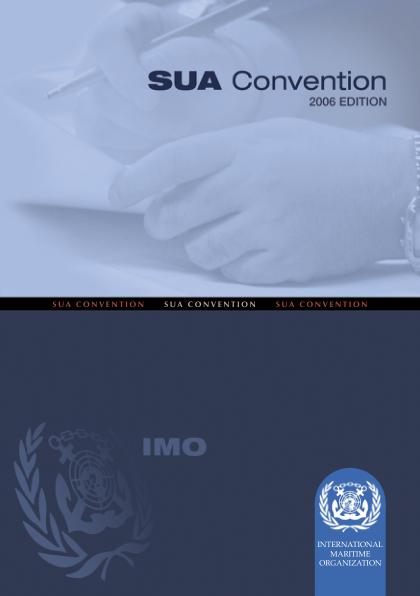Navigating the Threats to Maritime Security
 The vast expanse of the world’s oceans has long been a conduit for global trade, cultural exchange, and economic development. However, this openness also presents vulnerabilities. In 1985, the hijacking of the Italian cruise ship Achille Lauro and the tragic murder of a passenger underscored the pressing need for a robust international framework to address unlawful acts against maritime navigation. This incident catalyzed the development of the Convention for the Suppression of Unlawful Acts Against the Safety of Maritime Navigation (SUA Convention) in 1988, further strengthened by the 2005 Protocol.
The vast expanse of the world’s oceans has long been a conduit for global trade, cultural exchange, and economic development. However, this openness also presents vulnerabilities. In 1985, the hijacking of the Italian cruise ship Achille Lauro and the tragic murder of a passenger underscored the pressing need for a robust international framework to address unlawful acts against maritime navigation. This incident catalyzed the development of the Convention for the Suppression of Unlawful Acts Against the Safety of Maritime Navigation (SUA Convention) in 1988, further strengthened by the 2005 Protocol.
Understanding the SUA Convention: Foundations and Objectives
The SUA Convention, adopted in Rome on March 10, 1988, and entering into force on March 1, 1992, aims to ensure that appropriate legal action is taken against individuals committing unlawful acts against ships. As of June 2015, the Convention boasts 166 state parties, representing 94.5% of the world’s merchant fleet tonnage.
Key Objectives:
-
Criminalization of Unlawful Acts: The Convention defines and criminalizes acts such as seizing control of a ship by force, committing acts of violence likely to endanger the ship’s safety, and placing devices on ships that could cause damage.
-
Jurisdictional Clarity: It establishes the principle of aut dedere aut judicare, mandating that states either prosecute offenders or extradite them to a state willing to do so.
-
International Cooperation: The Convention fosters collaboration among states to prevent and respond to maritime threats effectively.
The 2005 Protocol: Addressing Emerging Maritime Threats
In response to evolving maritime security challenges, particularly the threat of terrorism and the proliferation of weapons of mass destruction (WMDs), the 2005 Protocol was adopted on October 14, 2005, and entered into force on July 28, 2010.
Enhancements Introduced:
-
Expanded Offenses: The Protocol criminalizes the use of ships to transport or discharge WMDs, including biological, chemical, or nuclear weapons, and prohibits the use of ships to discharge hazardous substances in quantities likely to cause harm.
-
Boarding Provisions: It introduces procedures for the boarding of ships suspected of engaging in prohibited activities, enhancing the ability of states to interdict threats on the high seas.
-
Strengthened Legal Framework: The Protocol reinforces the legal mechanisms for prosecuting individuals involved in maritime terrorism and related offenses.
Practical Applications and Case Studies
Implementation in National Legislation
Many countries have incorporated the provisions of the SUA Convention and its Protocol into their domestic laws. For instance, Nigeria has implemented the 1988 SUA Convention and its Protocol through its Terrorism (Prevention) Act, criminalizing maritime-related terrorist acts.
International Collaboration
The SUA framework has facilitated international cooperation in maritime security operations. Joint exercises and information-sharing initiatives among navies and coast guards have been instrumental in preventing unlawful acts at sea.
Challenges and Future Developments
Implementation Disparities
Despite widespread ratification, disparities in the implementation of the SUA Convention and its Protocol persist. Some states have yet to fully incorporate the provisions into their national legislation, hindering the effectiveness of the international legal framework.
Evolving Threat Landscape
The maritime security environment continues to evolve, with emerging threats such as cyber-attacks on maritime infrastructure and the use of autonomous vessels for illicit activities. Addressing these challenges requires continuous updates to the legal instruments and enhanced international cooperation.
Conclusion: Strengthening Maritime Security Through Legal Frameworks
The SUA Convention and its 2005 Protocol represent significant milestones in the international community’s efforts to safeguard maritime navigation. By criminalizing unlawful acts and fostering international cooperation, these instruments enhance the security of maritime activities. Continued commitment to their implementation and adaptation to emerging threats is essential for maintaining the safety and security of the world’s oceans.
Frequently Asked Questions (FAQs)
Q1: What is the SUA Convention?
A1: The SUA Convention is an international treaty that criminalizes unlawful acts against the safety of maritime navigation, such as hijacking and acts of violence against ships.
Q2: What does the 2005 Protocol add to the SUA Convention?
A2: The 2005 Protocol expands the scope of the SUA Convention by criminalizing the use of ships to transport or discharge WMDs and hazardous substances, and introduces provisions for boarding ships suspected of such activities.
Q3: How many countries are parties to the SUA Convention?
A3: As of June 2015, there are 166 state parties to the SUA Convention, representing 94.5% of the world’s merchant fleet tonnage.
Q4: Why was the SUA Convention developed?
A4: The Convention was developed in response to increasing threats to maritime security, notably the 1985 hijacking of the Achille Lauro, to provide a legal framework for prosecuting unlawful acts against ships.
Q5: How does the SUA Convention facilitate international cooperation?
A5: The Convention establishes mechanisms for extradition or prosecution of offenders and encourages states to collaborate in preventing and responding to unlawful acts against maritime navigation.

